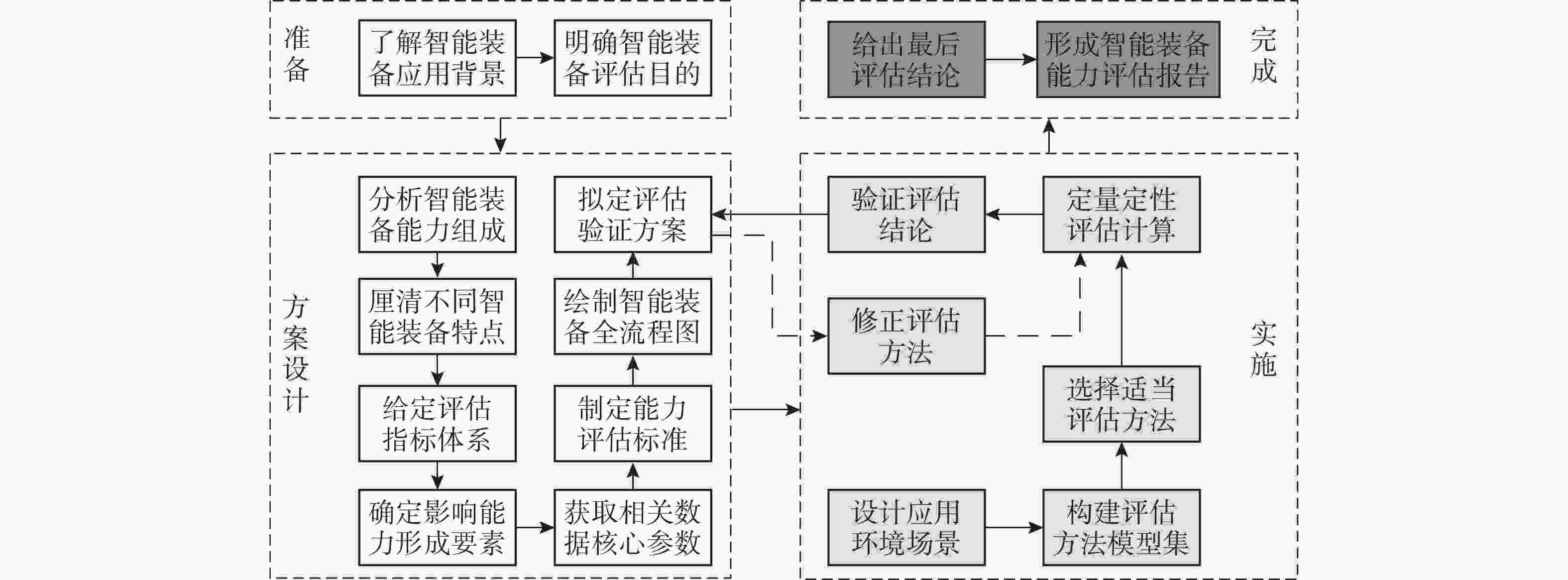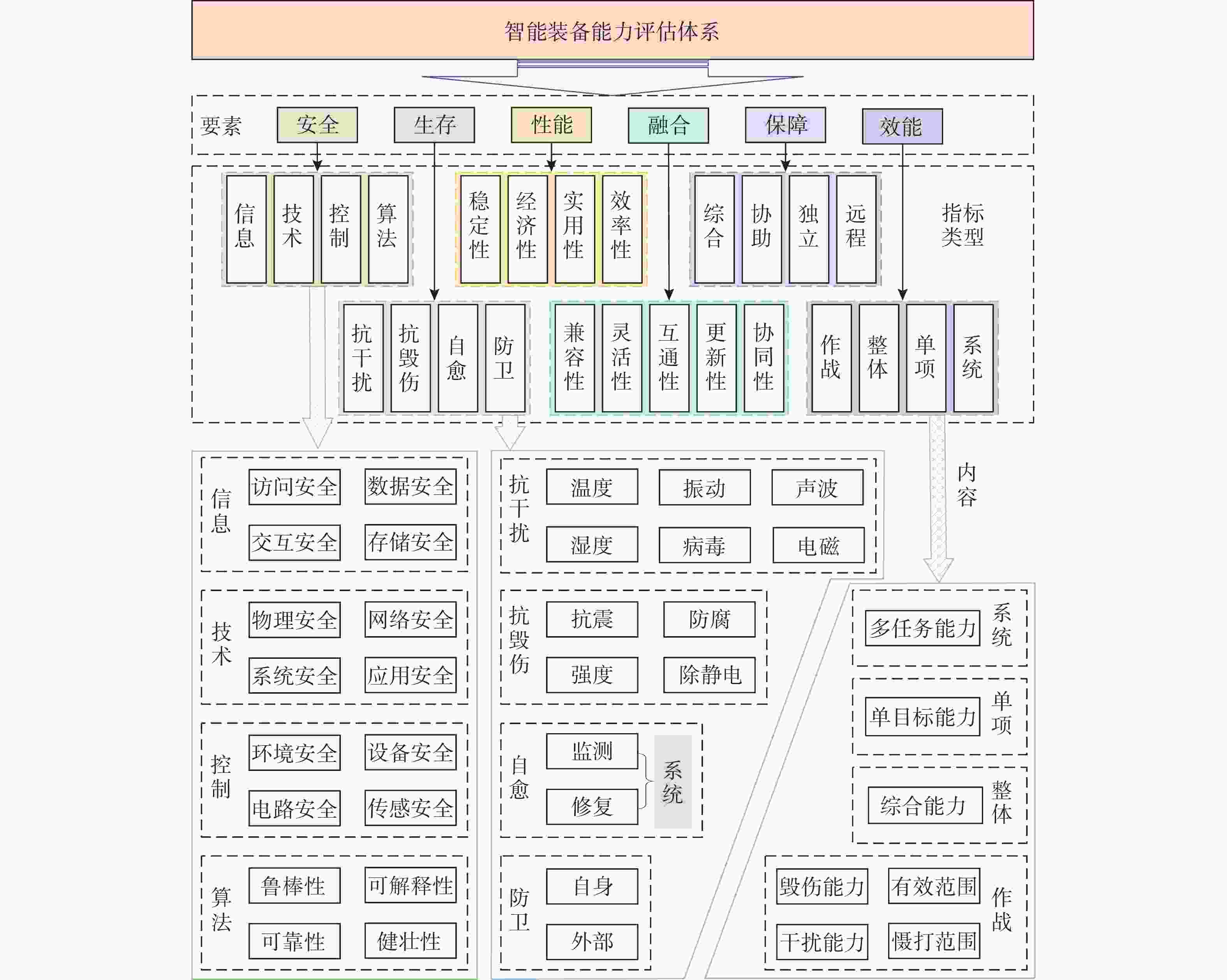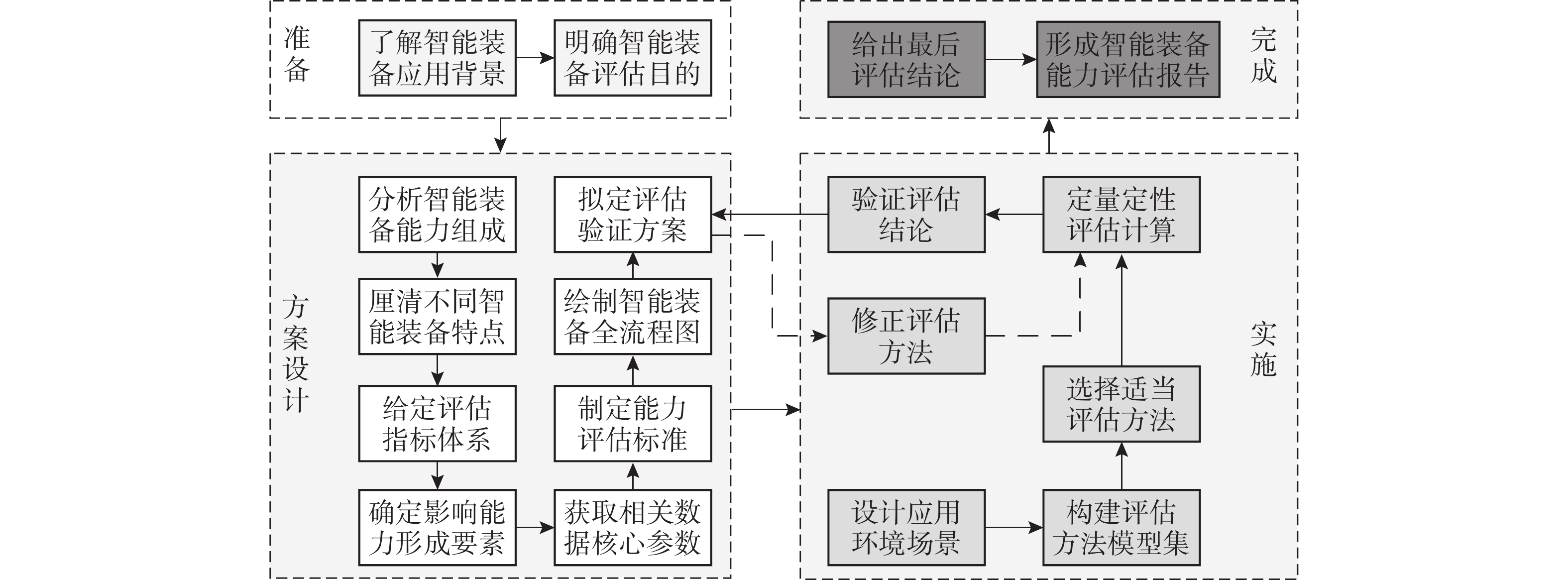Construction of Intelligent Equipment Capability Evaluation System
-
摘要: 人工智能发展促使战争形态与模式转变, 智能装备已成为智能化战争的核心力量。为了科学衡量智能装备能力, 针对当前面向智能装备评估存在的不足, 文中围绕评估方法、能力指标、核心要素和体系框架展开研究。首先, 系统梳理了传统装备能力评估的常用方法, 归纳总结智能装备评估整体思路; 其次, 从能力要求、性能参数和任务能力等方面, 深入分析了智能装备的能力指标; 再次, 细化智能化多维度能力构成, 给出了智能装备能力评估的关键要素组成; 最后, 提炼安全、生存、性能、效能、保障和融合6大标准模块, 构建了面向智能装备能力评估体系。该研究为智能装备的研发优化、作战效能提升及军事决策制定提供了科学的评估框架与方法支撑。Abstract: The development of artificial intelligence promotes the transformation of the form and mode of war, and intelligent equipment has become the protagonist of intelligent war. In order to measure the capability of equipment scientifically, aiming at the shortcomings of the current assessment of intelligent equipment, the research is carried out around the evaluation methods, indicators, elements and systems. Firstly, summarized the evaluation methods of equipment capability, and sorted out the ideas of intelligent equipment evaluation. Secondly, analyzed the capability index of intelligent equipment from the aspects of capability requirements, performance parameters and task capability. Then, refined the intelligent multi-dimensional capability, and given the elements of intelligent equipment capability evaluation. Finally, six standard modules are refined, and a capability evaluation system for intelligent equipment is constructed.
-
Key words:
- intelligent equipment /
- evaluation system /
- intelligent war /
- capability composition
-
表 1 不同类型的传统评估方法
Table 1. Different types of traditional evaluation methods
类型 方法 内容 特点 网络法 效果[6] 构建指标体系, 进行体系能力架构开发 层次开发与开放架构相结合 作战[7] 装备实体抽象成网络节点, 信息流为边 突出关联关系对能力的影响 仿真法 对抗仿真[8] 建立综合性对抗仿真环境, 以体系模型为背景 复杂系统、动态试验、多维对比 半实物仿真[9] 以情报数据为输入, 测量通过装备产生的输出 局部模型、局部实物 主观法 层次 分析法[10] 建立层次结构模型, 其次构造判断矩阵 定性和定量相结合 专家评价法[11] 设置等级区间和评分标准, 行业领域专家打分 基于专业知识和经验, 具有数理统计特性 客观法 加权分析法[12] 给评价指标或要素赋予权重 比较客观和全面, 综合考虑不同因素 回归[13] 通过数学模型来探究因变量和自变量之间的因果关系 因果变量具有统计学的显著性 复合法 模糊评估法[14] 确定隶属函数和等级, 利用判断矩阵和权重表述 结果是相对的, 明确应用场景和限制条件 聚类分析法[15] 数据分为多个等级或类别, 比较差异或相似性 多变量统计方法 效能分析法[16] 从多个层面衡量工作成果的尺度 关注效率和效果的综合评估 FA-ER[17] 基于函数将证据推理转换为非线性问题, 使用萤火虫算法寻优 克服评估主观性, 提高结果准确度, 适用性较好 -
[1] 曹良强, 周亮. 从伊拉克战争看2020年前后美军武器装备的发展[J]. 国防科技, 2008(3): 17-21.CAO L Q, ZHOU L. The development of US weapon systems around 2020 through the great changes of US weapon systems in the Iraq War[J]. National Defense Science & Technology, 2008(3): 17-21. [2] 兰顺正. 纳卡冲突中的现代武器及战术比拼[J]. 世界知识, 2020(24): 66-67.LAN S Z. Modern weapons and tactics in the Nagorno-Karabakh conflict[J]. World Affairs, 2020(24): 66-67. [3] 王京烈. 美国伊朗新一轮对抗及爆发战争的危险[J]. 云梦学刊, 2020, 41(3): 1-13.WANG J L. A new US-Iran confrontation and the risk of war[J]. Journal of Yunmeng, 2020, 41(3): 1-13. [4] 李大光, 季自力. 从俄乌冲突看智能化战争降维打击[J]. 光明军事, 2022, 10(21): 1-3.LI D G, JI Z L. Intelligent war dimensionality reduction strike from Russia-Ukraine conflict[J]. Guangming Military, 2022, 10(21): 1-3. [5] 王辉雄, 洪东跑, 刘宸宁, 等. 武器装备智能保障系统建模与效能分析[J]. 宇航学报, 2023, 44(2): 197-207.WANG H X, HONG D P, LIU C N, et al. Modeling and efficiency analysis for intelligent weapon equipment support system[J]. Journal of Astronautics, 2023, 44(2): 197-207. [6] 於进, 王鸿飞, 孙树岩, 等. 基于效果的体系能力评估方法[J]. 指挥信息系统与技术, 2021, 12(4): 28-33.YU J, WANG H F, SUN S Y, et al. Effect-based method for system capability evaluation[J]. Command Information System and Technology, 2021, 12(4): 28-33. [7] 梁家林, 熊伟. 基于作战环的武器装备体系能力评估方法[J]. 系统工程与电子技术, 2019, 41(8): 1810-1819.LIANG J L, XIONG W. Capabilities assessment of the weaponry system based on combat ring[J]. Systems Engineering and Electronics, 2019, 41(8): 1810-1819. [8] 胡晓峰, 杨镜宇, 张昱. 武器装备体系评估理论与方法的探索与实践[J]. 宇航总体技术, 2018(1): 1-11.HU X F, YANG J Y, ZHANG Y. Exploration and practice to the theory and method of evaluating weapon system of systems[J]. Astronautical Systems Engineering Technology, 2018(1): 1-11. [9] 邓剑挺, 黎之乐, 吴勇. 电子战装备告警侦察能力评估方法[J]. 电子信息对抗技术, 2020, 35(2): 66-70.DENG J T, LI Z L, WU Y. Evaluation method of warning & reconnaissance capability of electronic warfare equipment[J]. Electronic Information Warfare Technology, 2020, 35(2): 66-70. [10] 程浚, 陈岗, 周继权. 基于模糊层次分析法的侦察方案效能评估[J]. 指挥信息系统与技术, 2013, 4(4): 47-50.CHENG J, CHEN G, ZHOU J Q. Efficiency evaluation of reconnaissance solution based on fuzzy analytic hierarchy process[J]. Command Information System and Technology, 2013, 4(4): 47-50. [11] 张思琪, 王旭. 基于专家评价法的智能消毒门垫设计[J]. 机电技术, 2021(2): 28-30.ZHANG S Q, WANG X. Intelligent disinfection doormat design based on expert evaluation method[J]. Mechanical & Electrical Technology, 2021(2): 28-30. [12] 李文航, 余恒奇. 基于Hadoop平台的数据分析和应用[J]. 微型电脑应用, 2019, 35(11): 134-136, 146.LI W H, YU H Q. Data analysis and application based on hadoop platform[J]. Microcomputer Applications, 2019, 35(11): 134-136, 146. [13] 周猛, 付东翔. 基于回归分析法的汽车散热试件风洞测控系统[J]. 电子测量技术, 2019, 42(15): 88-92.ZHOU M, FU D X. Design of proportional model wind tunnel system based on regression analysis[J]. Electronic Measurement Technology, 2019, 42(15): 88-92. [14] 陈靖, 杨海波. 基于综合评价方法的导弹装备维修保障效能评估[J]. 舰船电子工程, 2021, 41(8): 110-114.CHEN J, YANG H B. Evaluation of maintenance support efficiency of missile equipment based on comprehensive evaluation method[J]. Ship Electronic Engineering, 2021, 41(8): 110-114. [15] 李向东, 陈序, 张欧博雅, 等. 基于层次分析-聚类分析法和动态权重的起重机风险评估方法[J]. 起重运输机械, 2023(4): 43-50.LI X D, CHEN X, ZHANG O B Y, et al. Risk assessment method of crane based on analytic hierarchy process-cluster analysis and dynamic weight[J]. Hoisting and Conveying Machinery, 2023(4): 43-50. [16] 赵德才, 汪陆平, 李骥, 等. 基于 ADC 模型对通信系统效能的评估方法[J]. 舰船电子工程, 2009(6): 96-98.ZHAO D C, WANG L P, LI J, et al. Efficiency evaluation of battlefield communication systems based on ADC model[J]. Ship Electronic Engineering, 2009(6): 96-98. [17] 李岩, 陈云翔, 罗承昆, 等. 基于FA-ER的装备保障资源供给能力评估方法[J]. 系统工程与电子技术, 2020, 42(3): 630-637.LI Y, CHEN Y X, LUO C K, et al. Evaluation method for the supply capability of equipment support resources based on FA-ER[J]. Systems Engineering and Electronics[J]. 2020, 42(3): 630-637. -





 下载:
下载:







